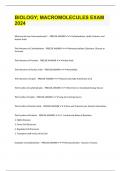Biology macromolecules - Study guides, Class notes & Summaries
Looking for the best study guides, study notes and summaries about Biology macromolecules? On this page you'll find 1122 study documents about Biology macromolecules.
Page 4 out of 1.122 results
Sort by

-
BIO 115 Final Exam Study Guide with Complete Solutions
- Exam (elaborations) • 31 pages • 2024
-
Available in package deal
-
- $10.49
- + learn more
BIO 115 Final Exam Study Guide with Complete Solutions 12 Principles of Biology Cells are the simplest unit of life Cell theory: (1) all organisms are composed of cells (2) Cells are smallest unit of life (3) new cells come from pre-existing cells Living organisms use energy (E) process called respiration metabolism: breakdown of cellular molecules Living organisms interact with their environment example: plants grow towards light source Living organisms maintain homeostasis maint...
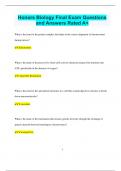
-
Honors Biology Final Exam Questions and Answers Rated A+
- Exam (elaborations) • 32 pages • 2024
- Available in package deal
-
- $9.99
- + learn more
Honors Biology Final Exam Questions and Answers Rated A+ What is the term for the protein complex that helps in the correct alignment of chromosomes during mitosis? Kinetochore What is the name of the process by which cells convert chemical energy from nutrients into ATP, specifically in the absence of oxygen? Anaerobic Respiration What is the term for the specialized structures in a cell that contain digestive enzymes to break down macromolecules? Lysosomes What is the...
BIOLOGY; MACROMOLECULES EXAM 2024

-
BMCC Bio 425 Exam Chapter 1-4 Latest Update Graded A+
- Exam (elaborations) • 15 pages • 2024
-
- $9.99
- + learn more
BMCC Bio 425 Exam Chapter 1-4 Latest Update Graded A+ What is the main focus of biology as a science? The main focus of biology is to study living organisms, their structures, functions, interactions, and the processes that sustain life. How do scientists ensure their findings are reliable and valid? Scientists ensure their findings are reliable and valid by using the scientific method, which includes forming hypotheses, conducting experiments, collecting data, and analyzing results...
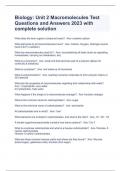
-
Biology: Unit 2 Macromolecules Test Questions and Answers 2023 with complete solution
- Exam (elaborations) • 11 pages • 2023
- Available in package deal
-
- $11.49
- + learn more
Biology: Unit 2 Macromolecules Test Questions and Answers 2023 with complete solution
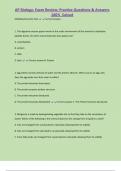
-
AP Biology: Exam Review: Practice Questions & Answers 100% Solved
- Exam (elaborations) • 94 pages • 2024
- Available in package deal
-
- $19.99
- + learn more
AP Biology: Exam Review: Practice Questions & Answers 100% Solved DNA/Biochemestry Test Correct answer--- 1. The digestive enzyme pepsin works in the acidic environment of the stomach to hydrolyze peptide bonds. On which macromolecules does pepsin act? A. carbohydrate B. protein C. DNA D. lipid Correct answer-B. Protein 2. Egg whites consist primarily of water and the protein albumin. When you fry an egg, why does the egg white turn from clear to white? A. The protein becomes d...

-
AP Biology: Macromolecules Latest Update Graded A+
- Exam (elaborations) • 8 pages • 2024
- Available in package deal
-
- $9.99
- + learn more
AP Biology: Macromolecules Latest Update Graded A+ Active Site A pocket/groove on the surface of a protein on the surface of the protein into which the substrate fits. The substrate is held to this area through weak interactions, such as hydrogen bonds or Van der Waals. Allosteric Enzymes Enzymes that can change their shape: one shape is active (reaction occurs) and one is inactive (reaction doesn't occur) Antibodies Bind to particular foreign substances that fit their binding si...
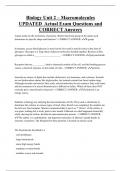
-
Biology Unit 2 – Macromolecules UPDATED Actual Exam Questions and CORRECT Answers
- Exam (elaborations) • 8 pages • 2024
- Available in package deal
-
- $8.99
- + learn more
Biology Unit 2 – Macromolecules UPDATED Actual Exam Questions and CORRECT Answers Amino acids are the monomers of proteins. Which functional group in the amino acid determines its specific shape and function? - CORRECT ANSWER- R group In humans, excess blood glucose is stored in the liver and in muscle tissue in the form of glycogen. Glycogen is a long chain of glucose molecules bonded together. Because of this, glycogen is called a _____________________. - CORRECT ANSWER- polysacch...
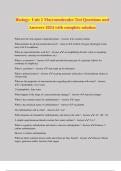
-
Biology: Unit 2 Macromolecules Test Questions and Answers 2024 with complete solution
- Exam (elaborations) • 11 pages • 2024
- Available in package deal
-
- $12.49
- + learn more
Biology: Unit 2 Macromolecules Test Questions and Answers 2024 with complete solution What does the term organic compound mean? - Answer ️️ -contains carbon What elements do all macromolecules have? - Answer ️️ -Carbon, Oxygen, Hydrogen (some have N & P in addition) What are macromolecules used for? - Answer ️️ -accomplishing all tasks (such as regulating homeostasis, carrying out metabolism, etc) What is a monomer? - Answer ️️ -small unit that becomes part of a polymer (a...

-
IB Biology Chapter 2 Latest 2024 Graded A+
- Exam (elaborations) • 11 pages • 2024
- Available in package deal
-
- $8.99
- + learn more
IB Biology Chapter 2 Latest 2024 Graded A+ Vitalism Idea that living organisms are fundamentally different from non living things Most frequently occurring elements Oxygen 65% Carbon 19% Hydrogen 10% Nitrogen 3% Other elements Calcium 1.5% Phosphorus 1% Iron 0.7% Sulfur 0.25% Sodium 0.15% Molecular biology Science that aims to explain living processes in terms of chemical substances Synthesis of urea Discovered in human urine in the 18th century Organic compound synt...

Did you know that on average a seller on Stuvia earns $82 per month selling study resources? Hmm, hint, hint. Discover all about earning on Stuvia

